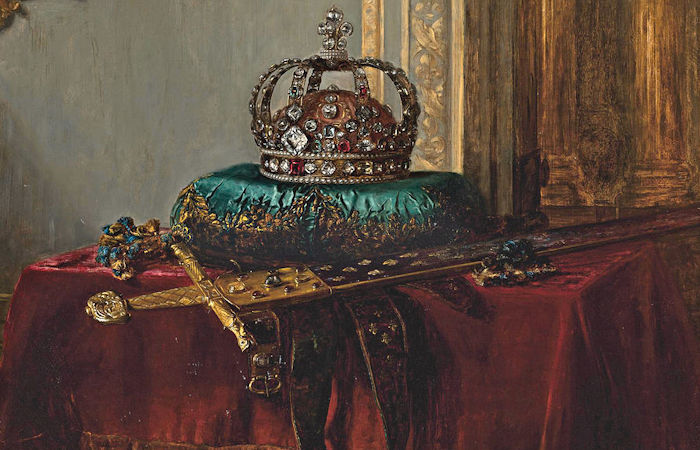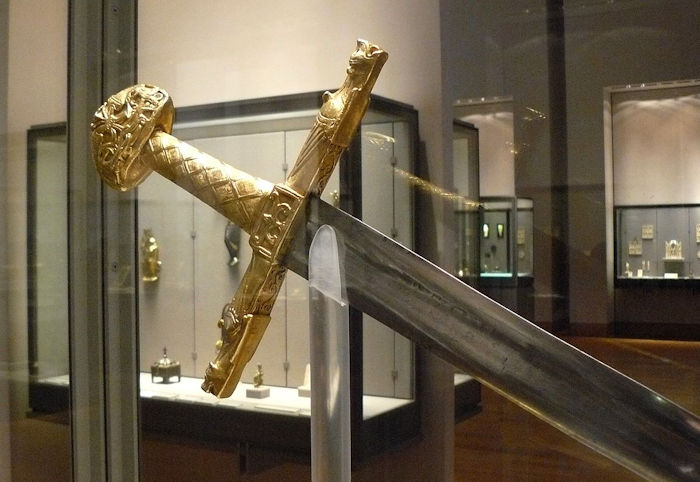‘Joyeuse’ – Legendary Sword With Relics Of Saints Was A Private Treasure Of Emperor Charlemagne
A. Sutherland - AncientPages.com - Many legendary weapons have been described in ancient documents and books. Some were authentic weapons, and others gained a mythical status that inspired artisans who created weapons for famous knights and warriors over centuries.
One such weapon is "Joyeuse" (which in French means "joyful") and is widely known as the legendary sword of Emperor Charlemagne. The fascinating fate of this sword can be found both in history and mythology, and these two sources of our knowledge lead us to one of the most dominating European rulers after the fall of the Roman Empire.
The crown jewels - Blaise Alexandre Desgoffe. Credit: Public Domain
Like Durendal and curtana, also an excellent weapon, the sword "Joyeuse" is mentioned in the famous French poem the Song of Roland," which makes it even more challenging to distinguish the truth about it from fiction.
This beautiful one-handed sword with a flat, double-edged, sharp wedge was forged about 802 AD by the famous blacksmith Galas, and it took three years to create this masterpiece. Designed for use with a shield held in the other hand, "Joyeuse" was initially decorated with dragons and later, with fleur-de-lis, a symbol associated with French royalty. However, this symbol was withdrawn for the coronation ceremony of Napoleon.
Charlemagne's mysterious sword was said to contain the relics of saints. Its magical power gave protection to the owner from death by poison. It could change color thirty times a day, and the sword blinded the enemy by shining brightly in the sun. It was almost the same with Excalibur, King Arthur's famous but legendary sword.
In the Christian emperor of the West, Charlemagne's hand, "Joyeuse," was not only a dangerous weapon but deadly. According to the 11th-century poem known as the "Song of Roland," the sword "Joyeuse" also took part in the Battle of Roncevaux Pass, between the rear guard of the Frankish troops of King Charlemagne, led by Count Roland, and the Basque Highlanders. At the Emperor Charlemagne's side hung "Joyeuse," "a sword such as none could match, and which changed its color thirty times a day…."
The sword was known for its various powers, one of which was the ability to spread a radiance stronger than the sun, capable of blinding entire armies standing before it.
In this battle on 15 August 778, most Franks died, including Count Roland himself.
In the Cathedral of Moulins, France, the end of the 15th century. Photo: Vassil/Wikipedia
Tradition has it that Charlemagne lost his sword once during a battle and promised enormous earthly possessions to whoever would return his personal and priceless treasure to him. One of the monarch's soldiers found the sword in the region called Ardèche (southeastern France). The emperor then kept his word. He drove the weapon to the ground and proclaimed his knight the ruler of this land, which he named "Joyeuse" after his sword.
The sword's fate after the death of Charlemagne in 814 remains unknown.
However, it became a national treasure used during the coronation of French kings. It appeared in 1270 in the cathedral of Reims during the coronation ceremony of Philip III The Bold. Later, "Joyeuse" played an essential role during the coronation of many monarchs in the following centuries, including the famous Louis XIV, also known as the enthronement as the Sun King, the longest-reigning monarch in European history.
Joyeuse, the famous sword of Charlemagne, on display in the Louvre, France. Credit: Siren-Com - Public Domain
All this time, the sword was kept in Saint-Denis, in the monastery, under the watchful eye of the monks. The blade, which ceased to serve as a weapon, was subjected to many cosmetic procedures over the following years. The sword received a more prestigious look. Other artisans added numerous ornaments and gave the sword's head, handle, irons, and sheath a more prestigious look. All these changes have made Joyeuse an exciting mix of aesthetic styles from all over Europe.
Does The Louvre Have Only A Replica Of "Joyeuse"?
No one knows for sure. After the French Revolution (1793), the sword was transported to the Louvre museum in Paris, where it remains. The last coronation with the sword's participation was in 1824 and concerned Charles X.
Today, some believe that the weapon in the Louvre is only a replica, but no official document confirms this.
The Joyeuse remains one of the most famous swords of the French state, which was the only one used during royal coronations for many centuries, representing a symbol of power and glory, but also prestige and elegance, as it has retained its dazzling appearance to this day. It is one of the most frequently copied weapons from the past.
Updated on July 19, 2022
Written by – A. Sutherland - AncientPages.com Senior Staff Writer
Copyright © AncientPages.com All rights reserved. This material may not be published, broadcast, rewritten or redistributed in whole or part without the express written permission of AncientPages.com
Expand for referencesReferences:
Janet L. Nelson, King and Emperor: A New Life of Charlemagne
Thomas Bulfinch, Legends of Charlemagne, or Romance of the Middle Ages
Ewart Oakeshott, Records of the Medieval Sword
More From Ancient Pages
-
 Nefertum – God Of Lotus Blossom, Perfumes, Aromatherapy, Beauty In Egyptian Mythology
Featured Stories | Apr 17, 2021
Nefertum – God Of Lotus Blossom, Perfumes, Aromatherapy, Beauty In Egyptian Mythology
Featured Stories | Apr 17, 2021 -
 Ancient Mystery Of A Lost Polar Civilization That Vanished Without A Trace
Ancient Mysteries | Dec 27, 2020
Ancient Mystery Of A Lost Polar Civilization That Vanished Without A Trace
Ancient Mysteries | Dec 27, 2020 -
 Alexander Nevsky: Grand Prince Of Novgorod, Skilled Fighter, Quick–Thinking Strategist Who Defeated Swedish And German Invaders
Featured Stories | Feb 22, 2019
Alexander Nevsky: Grand Prince Of Novgorod, Skilled Fighter, Quick–Thinking Strategist Who Defeated Swedish And German Invaders
Featured Stories | Feb 22, 2019 -
 Never-Ending Battle Of The Oak King and Holly King – Confrontation Of The Light And The Darkness
Celtic Mythology | Dec 17, 2021
Never-Ending Battle Of The Oak King and Holly King – Confrontation Of The Light And The Darkness
Celtic Mythology | Dec 17, 2021 -
 Beautiful Viking Uig Chessmen Recreated In 3D Images
Archaeology | Sep 17, 2019
Beautiful Viking Uig Chessmen Recreated In 3D Images
Archaeology | Sep 17, 2019 -
 Beautiful Ancient Egyptian Jewelry From The 26th Dynasty Unearthed At Karnak Temples
Artifacts | Mar 3, 2025
Beautiful Ancient Egyptian Jewelry From The 26th Dynasty Unearthed At Karnak Temples
Artifacts | Mar 3, 2025 -
 Varggrottan: Mysterious ‘Wolf Cave’ Was Home To Neanderthals 130,000 Years Ago – Oldest Human Dwelling In Scandinavia
Featured Stories | May 15, 2023
Varggrottan: Mysterious ‘Wolf Cave’ Was Home To Neanderthals 130,000 Years Ago – Oldest Human Dwelling In Scandinavia
Featured Stories | May 15, 2023 -
 Norse God Tyr Who Gave Viking Warriors Courage And Self-Confidence In Battle
Featured Stories | Mar 7, 2018
Norse God Tyr Who Gave Viking Warriors Courage And Self-Confidence In Battle
Featured Stories | Mar 7, 2018 -
 Hundreds Of Fascinating 24,000-Year-Old Cave Paintings Discovered In Eastern Iberia
Archaeology | Sep 11, 2023
Hundreds Of Fascinating 24,000-Year-Old Cave Paintings Discovered In Eastern Iberia
Archaeology | Sep 11, 2023 -
 Surprising Discovery Of Nabataean Underwater Temple In Puteoli, Italy
Archaeology | Sep 23, 2024
Surprising Discovery Of Nabataean Underwater Temple In Puteoli, Italy
Archaeology | Sep 23, 2024 -
 Evidence Of The Biggest Ever Solar Storm 14,300 Years Ago – Found In Ancient Tree Rings
Earth Changes | Oct 9, 2023
Evidence Of The Biggest Ever Solar Storm 14,300 Years Ago – Found In Ancient Tree Rings
Earth Changes | Oct 9, 2023 -
 Genetic Evidence Retrieved From 800,000-Year-Old Human Tooth
Human Beginnings | Apr 2, 2020
Genetic Evidence Retrieved From 800,000-Year-Old Human Tooth
Human Beginnings | Apr 2, 2020 -
 Runic Inscription On The Viking-Age Galloway Hoard Deciphered
Archaeology | Feb 13, 2025
Runic Inscription On The Viking-Age Galloway Hoard Deciphered
Archaeology | Feb 13, 2025 -
 65 Byzantine-Era Tombs Unearthed In Stratonikeia – World’s Largest Marble City
Archaeology | Feb 24, 2017
65 Byzantine-Era Tombs Unearthed In Stratonikeia – World’s Largest Marble City
Archaeology | Feb 24, 2017 -
 Amulets, Figurines Discovered In Recently Unearthed Limestone Sarcophagus In Minya, Egypt
Archaeology | Oct 15, 2020
Amulets, Figurines Discovered In Recently Unearthed Limestone Sarcophagus In Minya, Egypt
Archaeology | Oct 15, 2020 -
 Beware Of The Shapeshifting Gaelic Bodach Who May Be Difficult To Trick
Christmas Traditions | Dec 20, 2024
Beware Of The Shapeshifting Gaelic Bodach Who May Be Difficult To Trick
Christmas Traditions | Dec 20, 2024 -
 Roman Sexuality Was Far More Complex Than Simply Gay Or Straight – Pompeii’s House Of The Vettii Reveals Why
Featured Stories | Jan 24, 2023
Roman Sexuality Was Far More Complex Than Simply Gay Or Straight – Pompeii’s House Of The Vettii Reveals Why
Featured Stories | Jan 24, 2023 -
 Three 1850-Year-Od Stone Ossuaries Prevented From Looting Near Kafr Kanna In Galilee
Archaeology | Jun 21, 2023
Three 1850-Year-Od Stone Ossuaries Prevented From Looting Near Kafr Kanna In Galilee
Archaeology | Jun 21, 2023 -
 Rock-Cut Tomb Of Pennut, Viceroy Of Nubia Under Reign Of Ramses VI
Civilizations | Dec 7, 2018
Rock-Cut Tomb Of Pennut, Viceroy Of Nubia Under Reign Of Ramses VI
Civilizations | Dec 7, 2018 -
 Biblical Mysteries – Foods And Drinks That Gave Extraordinary Powers, Knowledge And Immortality
Ancient Mysteries | Mar 22, 2017
Biblical Mysteries – Foods And Drinks That Gave Extraordinary Powers, Knowledge And Immortality
Ancient Mysteries | Mar 22, 2017



